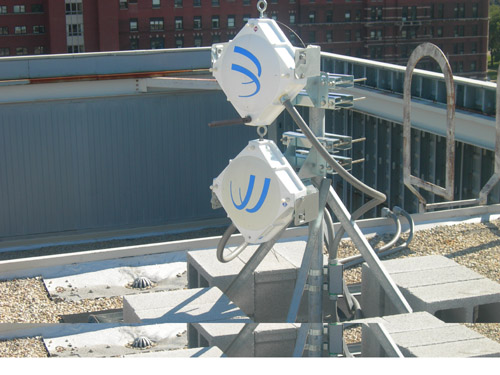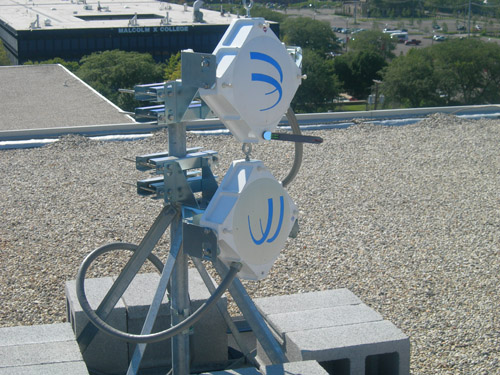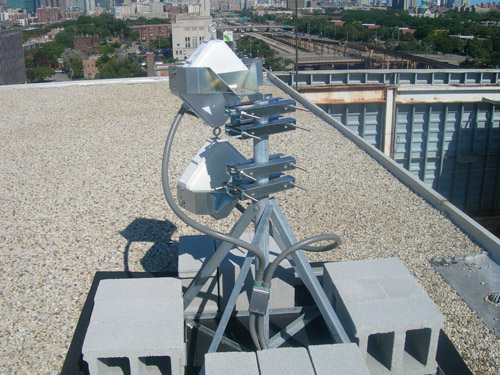Key Takeaways
- With a tight budget and short timeline, Rush University Medical Center needed to connect a temporary off-site facility to the campus data center’s network.
- After comparing fiber, free space optics, and gigabit wireless options, Rush chose FSO, only to switch to gigabit wireless radios after encountering weather issues that hampered FSO performance.
- In addition to quick implementation and lower operating costs than fiber, the wireless radios provided reliable, secure transmission of sensitive data.
Uninterrupted, high-bandwidth network connectivity is crucial for higher education. Colleges and universities increasingly adopt gigabit wireless solutions because of their fiber-equivalent performance, quick implementation, and significant return on investment. For just those reasons, Rush University Medical Center switched from free space optics to wireless radios to provide network connectivity to an outpatient care facility that was moved off-site during a construction project.
Background
Rush University Medical Center is a nonprofit organization that strives to incorporate cost-effective initiatives and utilize emerging technology to further benefit our patients and staff. Given the critical nature of transferring patient information, we depend heavily on our network’s security, reliability, speed, and compliance with HIPAA regulations. Sensitive patient data including medical records, claims, and financial information are regularly transferred from outpatient care facilities to the campus information services data center. In addition to the newly installed gigabit wireless link, our LAN also transfers data to and from more than 20 remote facilities back to the main campus. The remote facilities perform a multitude of functions, from outpatient care to financial services. One of the remote facilities, Rush Oak Park Hospital, demonstrates the diversity of the offsite facilities’ services. Some of the offsite facilities have regular hours and some are round-the-clock operations. All have various needs for data transfer.
Connectivity Challenges
The new state-of-the-art hospital is the centerpiece of a $900 million, eight-year campus redevelopment plan called the Rush Transformation Project. Phase I began in July 2007 with the construction of a new orthopedics ambulatory building, which is scheduled for completion this year. Phase II is the construction of the new hospital, which is scheduled for completion by 2012. The hospital will have more than 700 beds and 40 emergency department bays geared toward advanced emergency response. To make room for the construction, an outpatient care facility was relocated to leased space a block from campus. Despite this temporary move, the facility still required secure connections to the campus LAN in the information services data center. Our IT team needed to find a secure LAN data connection that met the following requirements:
- An overall cost within our limited budget of $200,000.
- Quick implementation to meet our short timeframe of one month.
- Bandwidth sufficient to transfer copious amounts of patient data, including patient records.
- HIPAA-compliant security for transmission of sensitive data to the main campus data center, about a mile away.
Fiber, Free Space Optics, and Gigabit Wireless
Traditionally, fiber has been the only choice for reliable high-bandwidth connections. Fiber offers the ability to increase capacity, is highly reliable, and provides security over long distances when it is physically present at the required locations or can be leased as well as installed at an acceptable cost point.
After our initial research and cost comparison between fiber installation and wireless options like free space optics (FSO) and gigabit wireless, we determined that the exorbitant costs associated with installing our own fiber between campus and the leased space a block away would exceed our budget of $200,000. The cost of trenching across the street and installing conduit to make the connection was already estimated at more than $300,000 — not including installation of the single-mode fiber. It was clear that only a wireless connection could help us stay within budget.
We then conducted lengthy research on wireless solutions and initially decided on an FSO link as the primary link and BridgeWave 60 GHz millimeter wave radios as the backup link. FSO is a line-of-sight technology that uses infrared beams of light to provide optical connections, whereas the millimeter wave line-of-site technology uses a concentrated radio beam to obtain a connection. Both the FSO link and the millimeter link were capable of transmitting 1 Gbps on an unlicensed frequency band, which eliminated the need to get FCC licenses while delivering the high bandwidth needed. The cost for the FSO and BridgeWave hardware along with installation costs came out to a little more than $90,000. We not only spent a little less than half of what we budgeted, our installation at both locations, antenna alignments, and testing for both links took only one week.
Once installed, the FSO link began dropping network connections, mainly due to high wind shears and poor mount design, resulting in numerous help-desk calls. The FSO system would have produced better results if the links had been placed indoors and the links from the upper floors of each building aligned through windows, thus preventing wind from affecting the performance. An auto-tracking feature on the FSO link was made to handle building sway, but not the harsh wind conditions of Chicago. There was not sufficient space indoors to move and erect the FSO equipment inside the building, so we eliminated that option. We quickly migrated traffic over to the gigabit wireless radio link as the primary connection medium. It immediately began transmitting traffic with zero errors. Once no errors had been recorded for 72 hours, we made the decision to return the FSO equipment and exchange it for a backup BridgeWave GE60 radio link. We have now been transmitting data over our BridgeWave Gig link for nearly a year and have experienced no data loss or any degradation is service.

The gigabit wireless radios are on the far left in this photo, on the roof of the building temporarily housing the outpatient care facility for Rush University Medical Center.
Going with Gigabit Wireless
Gigabit wireless links provide rapid ROI relative to the monthly recurring costs of leasing high-speed wired circuits. Leased-line OPEX costs for a gigabit fiber service would be tens of thousands of dollars a year, require long lead times for service delivery to most locations, and impose high installation costs that would vary depending on the location, whereas a gigabit wireless link can provide fiber-equivalent speeds and latency for a relatively low one-time expenditure and installation in less than a week. Rush relied on wireless gigabit technology to increase capacity and improve network performance as a temporary solution for our off-site outpatient care facility, but given the results to date, we have gained confidence that the gigabit wireless radios will provide the reliability we expect for data traffic in future projects, including voice traffic for our IP phones.
An added advantage to our wireless radio links accrues from the highly flexible spectrum regulations and the use of high-frequency bands. In the upper millimeter-wave radio spectrum (60 to 100 GHz frequency range), the large-spectrum allocations and narrow, pencil-like antenna beamwidths make 60 GHz and 80 GHz wireless links the preferred solutions to extend gigabit networks between sites or to connect sites into fiber-optic network backbones without dealing with the hassles of obtaining and paying for FCC licenses.
In addition, 60 GHz links are unique in the RF world, in terms of offering license-free operation without the interference risks associated with lower-frequency links. The combination of narrow antenna beamwidths (< 1.5 degrees) and the link-protection effects of 60 GHz oxygen attenuation make it highly unlikely that one 60 GHz link will interfere with another. These characteristics also make the links inherently resistant to data interception and denial-of-service attacks, providing physically secure radio connections and resilience to data loss.
We ultimately selected the BridgeWave 60 GHz, GE60 product after careful research of other products in the market and problems with free space optics. The 60 GHz links provided the best value, as we preferred license-free operation and had required link distances of generally less than one mile. The radios have helped extend our LAN network between campus buildings and the temporary leased space with error-free operation.



Views of the BridgeWave radios mounted on the roof of the building of the off-site facility, from the front right, front left, and rear.
Benefits to Rush and Next Steps
The IT department of Rush University Medical Center has leveraged the wireless gigabit links to provide reliable connectivity between the campus LAN and our leased space during the Transformation Project. The initial problems experienced using FSOs have been eliminated, and we have come to depend on the gigabit wireless radios for secure, rapid data transmission. Additional radio links will be considered as part of any proposal for connecting remote facilities in the future instead of based solely on traditional fiber. Our site surveys now determine if the gigabit wireless option is feasible as part of any projects that need connections offsite. Already, we have achieved complete ROI on the gigabit wireless installation, while also obtaining ample bandwidth for the outpatient care facility’s (leased space) needs. With the cost of a 60 GHz gigabit link on the order of $40,000 including labor and installation, our links have proven to be a cost-effective solution for any project that needs to connect remote facilities having line of site to the main campus. In addition, using the network settings on our wireless radios allows us to monitor network outages and react more quickly to anomalies in the system compared to waiting for a call-back from the service provider in the case of leased fiber lines. Given the dramatic decrease in costs using gigabit wireless compared to laying fiber, and the fiber-like performance of the wireless links, we are considering purchasing additional links for any additional remote sites needing LAN connections to the main campus. Because of the ultra-low latency of the links, the medical center also plans to use the gigabit wireless links to support the transfer of VoIP between the remote facility and the main campus as part of the migration to IP phones.
Summing Up
As the economy has shrunk over the last year, so too have IT budgets. A majority of IT’s capital budget dollars have been reallocated to the Rush Transformation Project, which means that any alternative for saving money is thoroughly investigated.
It is more important today than ever to come up with network alternatives that deliver the needed bandwidth and security at manageable costs. Rush University Medical Center’s total cost of ownership for the two gigabit wireless radio links is around $90,000 for materials and installation. This is half the cost of installing fiber and saves us the recurring charges for leased lines each month. Moreover, we do not need to be concerned whether the temporary site becomes permanent because we are not locked into service contracts.
The gigabit wireless links are approaching one year of service, and we have experienced zero transmission problems. The reliability of these 60 GHz radios has far surpassed our expectations and will be considered for any remote facility deployments in the future or if it makes sense to use them between buildings on the Rush campus.
© 2009 Eric Schoedel. The text of this article is licensed under the Creative Commons Attribution-Noncommercial-No Derivative Works 3.0 license, http://creativecommons.org/licenses/by-nc-nd/.
